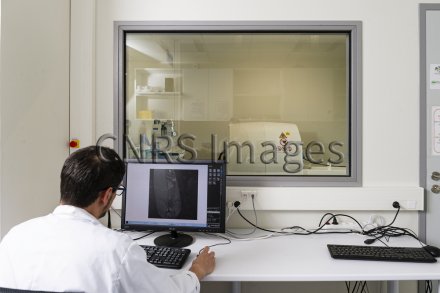Production year
2019

© Cyril FRESILLON / SETE / CNRS Images
20190066_0060
Etude des résultats de l'examen IRM (imagerie par résonance magnétique) d'un axolotl, "Ambystoma mexicanum". Des examens IRM et échographiques permettent d'observer le développement des gonades des axolotls élevés à la Station d’écologie théorique et expérimentale (SETE) de Moulis, en Ariège. L'axolotl est un amphibien néoténique : il reste toute son existence à un stade larvaire à cause d'une déficience hormonale, bien qu'il acquière la capacité de se reproduire. Exclusivement aquatique, il conserve des branchies externes à l'âge adulte alors que les amphibiens s'adaptent généralement à un mode de vie terrestre (à respiration pulmonaire). A la SETE, il est surtout utilisé comme "modèle" comparatif dans le cadre d'études sur le protée, un autre amphibien néoténique. Le service d'IRM de la SETE, qui appartient à l'infrastructure AnaEE France, permet la caractérisation phénotypique in vivo des petits animaux.
The use of media visible on the CNRS Images Platform can be granted on request. Any reproduction or representation is forbidden without prior authorization from CNRS Images (except for resources under Creative Commons license).
No modification of an image may be made without the prior consent of CNRS Images.
No use of an image for advertising purposes or distribution to a third party may be made without the prior agreement of CNRS Images.
For more information, please consult our general conditions
2019
Our work is guided by the way scientists question the world around them and we translate their research into images to help people to understand the world better and to awaken their curiosity and wonderment.